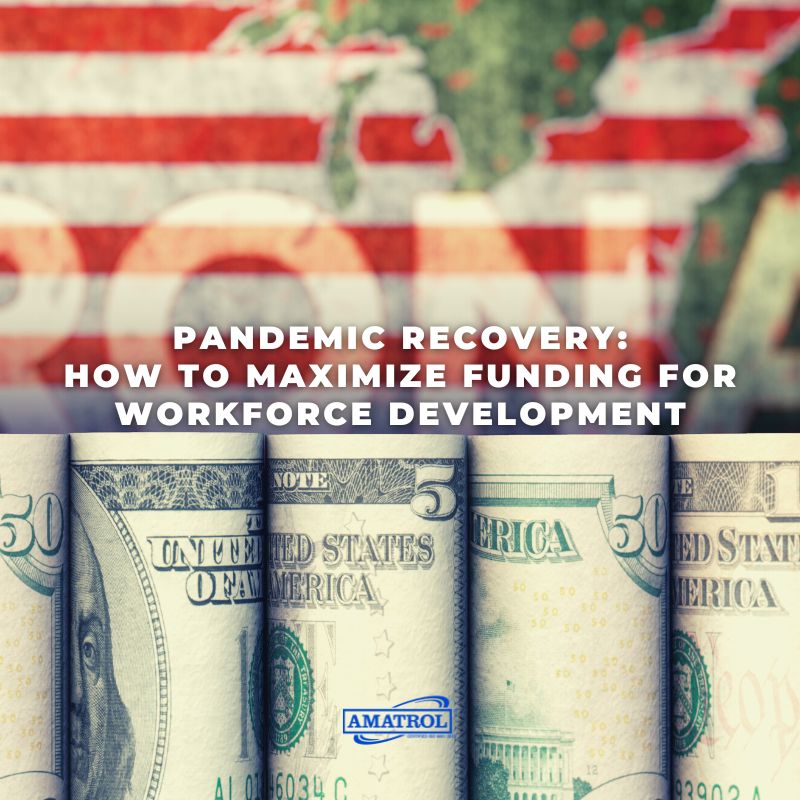 What do you remember about 2020? For most people, “COVID-19” and “pandemic” are words forever etched in their memories of that year. When the ball dropped in Times Square, pushing us all into 2021, we had high hopes that the worst was behind us.
What do you remember about 2020? For most people, “COVID-19” and “pandemic” are words forever etched in their memories of that year. When the ball dropped in Times Square, pushing us all into 2021, we had high hopes that the worst was behind us.
Of course, things didn’t really go as we had hoped, though. 2021 brought new and continuing challenges, and the ripple effects of the pandemic, such as supply chain disruptions, linger on well into 2022.
Billions of dollars of federal funding have been made available to state and local governments, but economic recovery has been slow and serious challenges remain. How can recipients maximize the effect available funding can have on workforce development?
Fortunately, nonprofit organization America Achieves has put together a playbook for state and local governments, titled Employing Residents in High-Demand Careers: An Evidence-Based Good Jobs-Driven Approach (the “Playbook”). In this article, we’ll take a closer look at the problems identified by America Achieves and what solutions the Playbook offers to state and local governments looking to jump-start economic recovery.
Challenges Remain
Way back in 2020, not many people expected we would see as many “Help Wanted” signs as we still find in 2022. As the economy begins to recover, it’s clear that a seismic shift has taken place in the modern workplace.
For workers and companies alike, the workplace landscape has forever changed, and no one expects it will return quickly to the way it was before, if at all. What exactly is going on now that the pandemic has seemingly subsided?
As America Achieves notes, “COVID-19 has exacerbated existing trends for both workers and employers — workers who have lost jobs in hard-hit sectors are struggling to reposition themselves in the workforce, while employers in high-demand sectors are left with vacant positions, finding it challenging to find and hire qualified workers.”
What many people misunderstand is the fact that the problems we see so clearly now existed long before the pandemic. COVID-19 just highlighted the problems and made them much worse. America Achieve summarizes the problem like this: “Employers face an unmet need for diverse pipelines of skilled workers, especially in high-demand sectors, while workers in need of employment face too many barriers to attaining the necessary skills and credentials for secure, sustainable jobs that offer a livable wage.”
Workers Need Skills
Saying that workers need skills seems like the most obvious statement one could make concerning the current workforce development crisis, but things were not always this way. As recently as a couple decades ago, nothing more than a high school degree could lead the way to a solid middle-class lifestyle.
Today, however, most jobs that provide a solid income with potential for advancement require some form of education beyond high school. However, only about a third of the current U.S. population possesses a college degree.
According to America Achieves, “the importance of alternative post-secondary credentials, such as vocational or technical education, has never been greater. These alternative credentials are often overlooked and undervalued, but can be critical pathways to well-paying jobs in our modern economy.”
Unfortunately, most “communities lack a comprehensive strategy to help workers gain the skills and support needed for a well-paying, family-supporting career.” That’s why America Achieves created the Playbook as part of its State Recovery Now initiative. It is intended to provide “state and local governments with innovative, step-by-step strategies for offering people effective pathways to good careers and for helping employers fill in-demand jobs – all grounded in a strong evidence base.”
A Career Pathway Forward
America Achieves CEO Jon Schnur has this to say about the Playbook:
“As states and communities work to rebuild after the devastation of the pandemic, it is crucial to help fill in-demand jobs and offer people pathways to attain good jobs and economic mobility – including by leveraging existing skills, and building new ones. This guide offers practical, evidence-based strategies that states and communities can use right now to address these challenges and build a good jobs economy for everyone.”
Project lead Bill Ferguson adds:
“State and local leaders are facing an unprecedented moment in time in recovery as they attempt to lead efforts to emerge on the other side of a once-in-100-year pandemic. Building a stronger, more resilient, and more competitive workforce in their jurisdictions is central to every state and local leaders’ recovery agenda. The Good Jobs-Driven Approach playbook provides an outline for leaders to incorporate as they deploy historic federal resources to retool workforce pathways in their states and local jurisdictions.”
In a nutshell, the Playbook “is the first in what will be a suite of action-oriented resources. The detailed guide is intended to support states, counties, and cities as they consider how best to allocate and implement hundreds of billions in state and local economic aid that is now available for spending from the American Rescue Plan (ARP) enacted last year.“
Focused Spending
The Playbook provides state and local officials with a detailed game plan for implementing “a system to match workers to – and then help them maintain – good jobs in well-paying, high-demand fields.” The Playbook features a two-pronged approach:
- Create a scholarship program driven by employer demand that provides funding for tuition for job training programs, career coaching, and essential support, such as transportation and child care; and
- Implement a comprehensive evaluation system to generate data about program impact and the quality of job training, so that improvements can be made and future decisions can be driven by hard evidence.
America Achieves believes linking funding to evidence-based programs will allow more job seekers to find career pathways with a greater chance of long-term success. This will have both short-term and long-term positive effects:
“In the short-term, this will lead to a greater availability of high-quality programs, as new and existing job training programs strive to qualify for funding by meeting evaluation criteria. This evaluation system will also build the evidence base for what works, helping policymakers and career advancement services to better understand ways to achieve desired outcomes and better serve residents in need of support. In the long-term, a successful program will lead to more residents employed in high-demand, family-supporting jobs. This should result in sustained wage gains over time for job training participants, while closing labor shortage gaps in key economic sectors.”
Amatrol Helps to Lead the Way
America Achieves highlights the approaches taken by several states that are “pioneering new, evidence-based approaches.” For example, it notes that “Indiana’s Next Level Jobs program provides free training for eligible residents exclusively in high-paying, high-growth fields like advanced manufacturing, transportation and logistics, and health and life sciences.”
Amatrol, the world’s leader in technical education training systems and eLearning curriculum for more than 30 years, has been instrumental in helping willing Hoosiers to gain valuable skills. Amatrol teamed up with Ivy Tech, Aidex, and the Smart Automation Certification Alliance (SACA) to offer six training courses and SACA credentials at no cost. SACA provides nationally recognized task-based credentials in advanced manufacturing and Industry 4.0 technologies.
Whether you’re a high school or college instructor, an employer, or a state or local official looking to implement new strategies to prepare students and current workers for the highly-skilled jobs currently in demand, Amatrol can help. Consult with an expert at Amatrol today to learn how you can take the first step toward teaching your students or current workers the skills that will set them up for success in the modern workplace.
About Duane Bolin
Duane Bolin is a former curriculum developer and education specialist. He is currently a Marketing Content Developer in the technical training solutions market.





